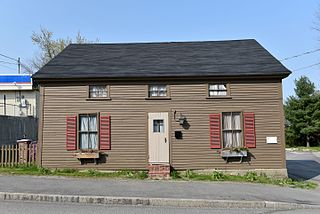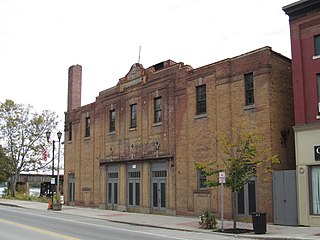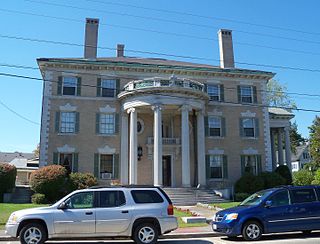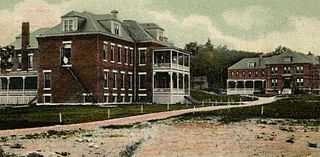
Augusta is the capital of the U.S. state of Maine and the county seat of and most populous city in Kennebec County. The city's population was 18,899 at the 2020 census, making it the twelfth-most populous city in Maine, and third-least populous state capital in the United States after Montpelier, Vermont, and Pierre, South Dakota.

The Maine State House in Augusta, Maine, is the state capitol of the State of Maine. The building was completed in 1832, one year after Augusta became the capital of Maine. Built using Maine granite, the State House was based on the design of the Massachusetts State House.

The Blaine House, also known as the James G. Blaine House, is the official residence of the governor of Maine and their family. The executive mansion was officially declared the residence of the governor in 1919 with the name "Blaine House". It is located at Capitol and State streets in Augusta, across the street from the Maine State House.

St. Mark's Episcopal Church was a historic church at 9 Summer Street in Augusta, Maine, just west of downtown. The congregation, founded in 1840, occupied an 1886 Gothic Revival stone building designed by Richard M. Upjohn and listed on the National Register of Historic Places in 1984 for its architecture. The congregation moved out in 2015.

St. Mary's Church is a Roman Catholic church at 41 Western Avenue in Augusta, Maine. Built in 1926, it is one of the city's finest examples of Gothic Revival architecture. It was listed on the National Register of Historic Places in 1987.

The Bond Street Historic District is a residential historic district on Bond Street in Augusta, Maine, United States. The district comprises seven residential buildings built primarily in 1884 by Edwards Manufacturing Company, which was a textile manufacturer in the area. The buildings housed mill workers and their families from 1878, when the first building was constructed until 1946, when the properties were sold to private owners. The buildings are the only surviving mill worker housing in Augusta. The district was listed on the National Register of Historic Places in 2014.

Capitol Park is a state-owned public park in Maine's state capitol complex on the west side of Augusta, Maine. Set aside in 1827, when the complex was established, the park, set between the Maine State House and the Kennebec River, served as a parade ground and encampment site during the American Civil War, and saw agricultural use before being formally designed as a park in the 1920s by the Olmsted Brothers. The park was listed on the National Register of Historic Places in 1989.

The Crosby Street Historic District encompasses a collection of well-preserved high-quality early 19th-century houses on Crosby Street and Crosby Lane in Augusta, Maine. Located on a rise overlooking the city's downtown, these houses were built by leading businessmen of the period, and are either Federal or Greek Revival in their style. The district was listed on the National Register of Historic Places in 1986.

The Colonial Theater is a historic movie theater at 139 Water Street in downtown Augusta, Maine. Built in 1913 and rebuilt after a fire in 1926, it is a fine example of Beaux Arts architecture, with features presaging the Art Deco movement. It is the last surviving movie theater building in downtown Augusta. It was listed on the National Register of Historic Places in 2014, at which time had been standing vacant for many years.

The Dr. J.W. Ellis House is a historic house at 62 State Street in Augusta, Maine. Built in 1855 for a prominent local doctor, it is a fine example of late Greek Revival architecture. It was listed on the National Register of Historic Places in 1979.

The Guy P. Gannett House is a historic house at 184 State Street in Augusta, Maine. Built in 1911 to a design by Boston architect James Thomas, it is the only significant example of Mediterranean Revival architecture in Kennebec County. It was listed on the National Register of Historic Places in 1983.

The Governor Hill Mansion is a historic house at 136 State Street in Augusta, Maine. It was built in 1901 for John F. Hill to a design by John Calvin Stevens, and is one of the state's grandest examples of Colonial Revival architecture. It now serves as an event facility. It was listed on the National Register of Historic Places in 1977.

The Journal Building is a historic commercial building at 325-331 Water Street in downtown Augusta, Maine. Built in 1899 to a design by Arthur G. Wing, it is a fine local example of commercial Renaissance Revival architecture. It was for main years home to Augusta's leading newspaper, the Kennebec Journal. It was listed on the National Register of Historic Places in 1986. It is now occupied by facilities of the University of Maine at Augusta.

The Kennebec County Courthouse is located at 95 State Street in Augusta, Maine, the state capital and county seat of Kennebec County. Built in 1829 and twice enlarged, it is one of the oldest examples of Greek Revival architecture in the state, and its earliest known example of a Greek temple front. The building, which is now mostly taken up by county offices, was listed on the National Register of Historic Places in 1974.

The Maine Industrial School for Girls, also once known as the Stevens School and the State School for Girls in Hallowell, is a former juvenile detention and education facility on Winthrop Street in Hallowell, Maine. The school operated from its founding in 1874 until the mid-1970s. Its campus, listed on the National Register of Historic Places, housed a variety of state offices, and a state Department of Corrections pre-release center until 2003 when the state put the complex up for sale and began moving offices off campus. The site remained unsold until 2016, when it was purchased by Mastway Development, LLC of Winthrop, Maine. Since then the main building has been completely renovated to serve as a 36 bed student dormitory for the University of Maine at Augusta which opened in August 2019.

The Maine Insane Hospital, later the Augusta Mental Health Institute (AMHI), was a psychiatric hospital in Augusta, Maine. It was the principal facility for the care and treatment of Maine's mentally ill from 1840 to 2004, and its surviving buildings represent the oldest surviving complex of mental care facilities in the United States. The complex is located on the east bank of the Kennebec River, immediately south of the former Kennebec Arsenal, and now primarily houses state offices. In 2004, the hospital was replaced by the Riverview Psychiatric Center, located just to the south. The hospital's core complex was listed on the National Register of Historic Places in 1982, with the listing enlarged to encompass the entire campus in 2001.

The Lot Morrill House is a historic house at 113 Winthrop Street in Augusta, Maine. Built about 1830, it is a fairly typical example of Greek Revival architecture, executed in brick. The house is notable as the home of United States Senator and Governor of Maine Lot Morrill during the period when he was at his height of power. It was listed on the National Register of Historic Places in 1974.

The Tappan-Viles House is a historic house at 150 State Street in Augusta, Maine. Built in 1816 and restyled several times, the house exhibits an eclectic combination of Federal, Italianate, and Colonial Revival styles, the latter contributed by architect John Calvin Stevens. The house was listed on the National Register of Historic Places in 1982; it is now part of a bank complex.

The Waterville Main Street Historic District encompasses the best-preserved portions of the historical commercial downtown area of Waterville, Maine. Developed most intensively in the late 19th and early 20th centuries, this area was the center of commerce for Waterville and the surrounding rural communities. It encompasses 25 properties on Main and Common Streets, including the Waterville Opera House and City Hall. It was listed on the National Register of Historic Places in 2012, and was slightly enlarged in 2016.

The Winthrop Street Historic District encompasses a predominantly residential area of Augusta, Maine encapsulating about 100 years of residential home development. The area features high-quality and well-preserved examples of homes from the early 19th to early 20th centuries, as well as two churches and the Lithgow Library. The district occupies a roughly triangular area west of downtown Augusta and north of the state capitol district. It was listed on the National Register of Historic Places in 2001, and enlarged slightly in 2008.






















